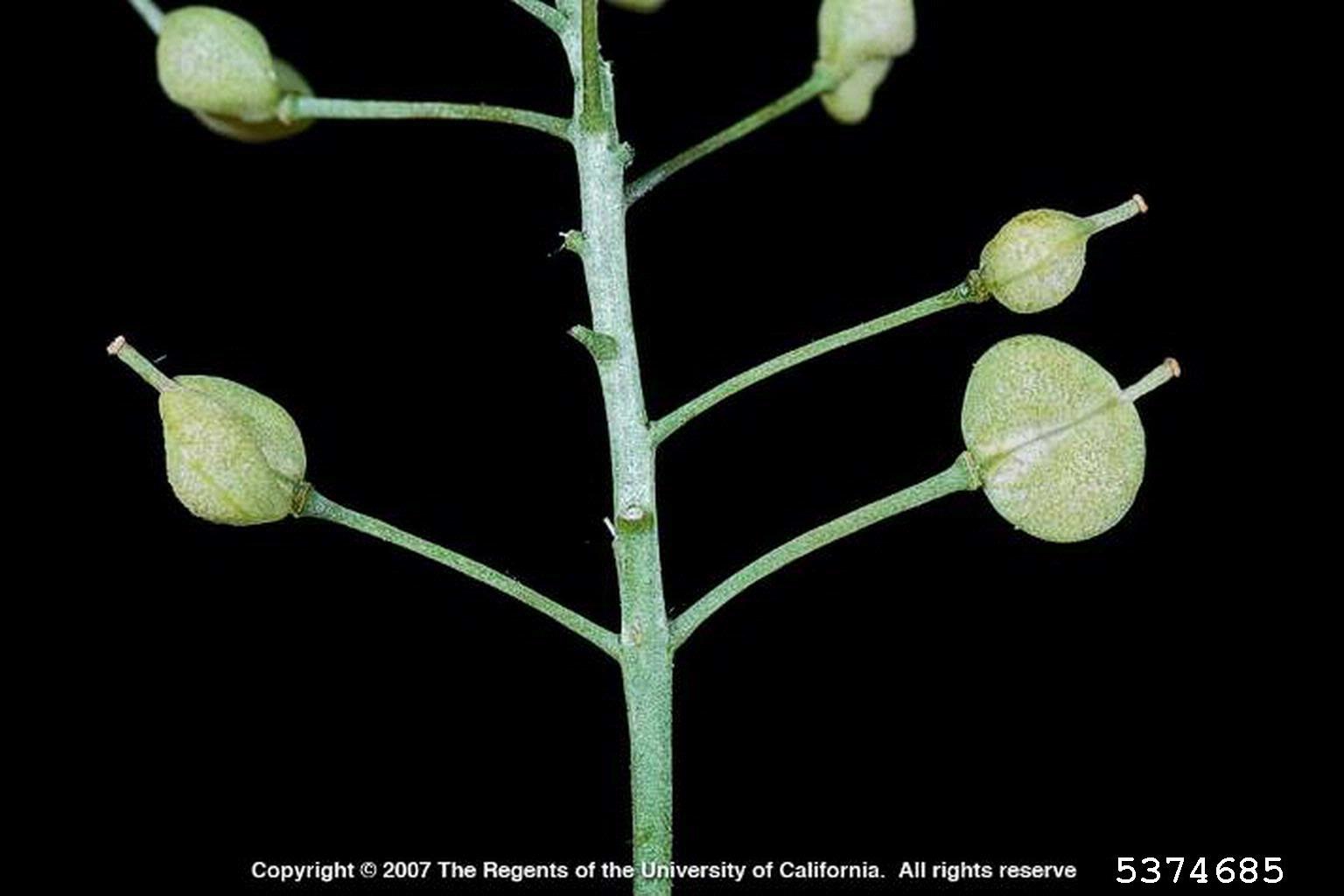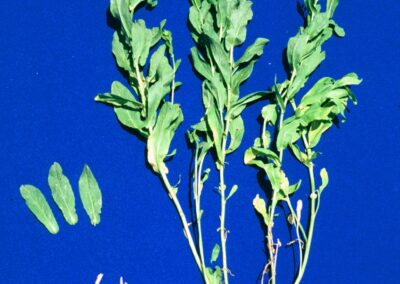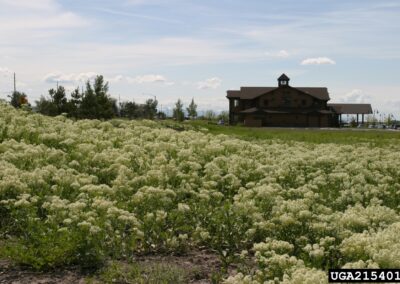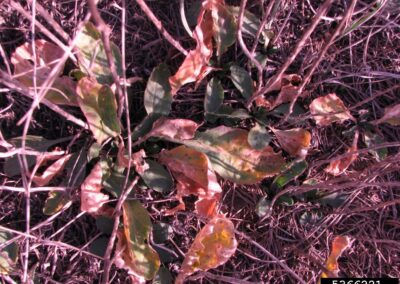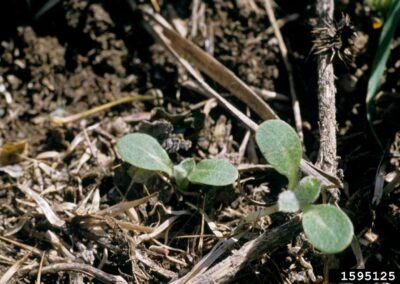
Hoary Cress
Lepidium draba
Class A Noxious Weed
This plant is new to the state and has been designated a Class A Noxious Weed by the New Mexico Department of Agriculture.
Read more >>>
Agricultural Threat
This plant threatens our state's food security and economy by reducing agriculture yields and/or degrading soil resources.
Read more >>>
Livestock Hazard
This plant presents a threat to the health and/or quality of livestock.
Read more >>>
QUICK FACTS
- Hoary Cress (or whitetop) is a perennial nuisance for farmers and ranchers, though it can be just as pernicious in urban settings.
- On top of its usual invasive characteristics, hoary cress is also allelopathic: it leaches toxic compounds into the surrounding soil, making it inhospitable to other plants even after it has been removed.
- It is excellent at invading irrigated pastures, croplands, and acequias, where it displaces both native species and agricultural plants and severely reduces forage quality for livestock and wildlife. While the young plant can be palatable, it is known to produce tainted milk in dairy cows.
- Hoary cress produces new shoots from its expansive root systems, quickly dominating landscapes with a monoculture of clones. Without competition, one plant can create over 450 shoots ayear from its creeping root system, which can grow so large as to reach the water table below.
1. Overview
If you have ever looked out at a field and saw what looks like a blanket of snow topping the otherwise green foliage, or if you have dabbled in any sort of agricultural practices, you have probably come across hoary cress. This showy and prolific weed can easily outcompete crops and range forage, quickly leading to an out-of-control invasive monoculture and economic disaster.
History of Hoary Cress
The word “draba” is derived from the Greek word for “acrid,” which describes a group of plants similar to mustards that the ancient Greeks recognized thousands of years ago. The seeds can be used as a substitute for pepper, likely contributing to its name.
Hoary Cress, scientifically known as Lepidium draba, is a perennial plant that originally hails from regions in the Near East, specifically Israel, Iraq, Iran, and parts of the Balkan Peninsula, Armenia, Syria, and Turkey. Over time, this hardy species has been widely disseminated and can now be found thriving on every inhabited continent across the globe.
The plant was first documented in the United States in 1862 on Long Island, New York. It is widely believed that early American settlers introduced it to New England by bringing contaminated alfalfa seed imported from Europe, a common practice during that era.
Today, Hoary Cress has established itself in nearly every state of the U.S. This aggressive weed is known for its ability to displace native flora, posing a significant threat to local ecosystems. Its proliferation leads to the degradation of rangelands, where it competes vigorously with indigenous species for resources. As a result, the management and control of Hoary Cress have become crucial for maintaining biodiversity and the health of various natural habitats.
2. ID Guide
What does it look like?
Hoary cress in New Mexico can be easily mistaken for perennial pepperweed (aka tall whitetop), a similar-looking relative from the mustard family. How can you tell which is which? Look out for the upper leaves – the bases of hoary cress leaves will clasp around the main stalk.Hoary cress is much shorter than perennial pepperweed, which reaches a minimum of 2-4 feet tall.
Having trouble identifying a weed? Contact us.
Key Features
- Short perennial plant, can grow up to 2 feet tall but most often remains below knee-level
- Each plant has a central stalk, from which multiple stems emerge outward like an umbrella
- Leaves: alternate on the stem; dark green to blue-green, often slightly waxy leaf surface can be wavy, and margins are inconsistently toothed
- Leaves closer to the bottom have small stems attaching them to the main stalk; further up, the bases of the leaves are clasped around the main stalk
- Flowers: dense clusters of tiny flowers, each with 4 petals; clusters form at the tops of stems, which themselves emerge from a central stalk, such that the flowers all emerge at the same level, forming a flat top
- Fruit: Heart-shaped or oval pods grow upside down, less than ½ inch in size
- Opening up the pods reveals 1 to 2 seeds in each chamber, egg-shaped and reddish-brown in color
Note: These are general identification guidelines. The appearance of individual plants can vary significantly based on growing conditions and the surrounding environment. Plants growing undisturbed will display more vigor than plants that grow under continuous disturbance.
hoarycress-wilted
Environmental stressors, such as fungus, winter frost, parasites, and herbicide treatment can heavily impact the appearance of the plant. Symptoms of stress include discolored, wilted stems, and holes in the leaves.
3. Infestation Basics
“Once the weed is established, it will require the most persistent efforts of farmers who are awake to the seriousness of this pest to completely eradicate it as one individual plant which escapes them is able to re-seed the field.”
-Burdick & Peitersen 1920
Why is it so invasive?
Extensive root systems are at the core of this plant’s invasive strategy. Its root system spreads prolifically, leaching out toxic chemicals and sprouting new plants. In this way, hoary cress can quickly colonize an area, and make it unsuitable to host any other plants.
Extensive, creeping root systems give hoary cress much of its competitive advantage over other plants. Unlike most plants, which lose their taproot early in life, hoary cress retains it; the taproot usually grows to about five feet but can reach depths of over ten feet. The lateral roots, which spread out horizontally, are especially problematic, as they can reach distances of more than thirty feet from the parent plant. Eventually, the lateral roots will turn downward and can often extend all the way down to the water table.
Hoary cress is able to sprout new, genetically identical plants from its sprawling root system, an example of vegetative reproduction. Each one of these plants can produce up to 4800 seeds, but the explosive spread of infestation is primarily due to the root system’s characteristics, forming large colonies of connected clones around the parent plant. Not only that, but under favorable conditions a new hoary cress plant can actually regenerate as a sprout from just a tiny one-inch root fragment, although this form of regeneration is less effective in dry soils.
Where hoary cress is spreading, its aggressively spreading root system will leave little room or resources for other plants to grow. Even the most tenacious of competitors will struggle to thrive around hoary cress, and for the ones that manage, hoary cress has a final trick up its sleeve: allelopathy. This is a type of chemical warfare that certain plants have developed, releasing compounds that inhibit the growth of neighboring plants. This gives it a significant competitive advantage, allowing it to not only physically spread through its root system but also chemically suppress potential competitors in its vicinity.
Key takeaway: Hoary cress spreads primarily through vegetative clones, which readily sprout from its fast-spreading root system. Once established, it also suppresses other plants by releasing toxic compounds into the soil, making the area inhospitable for any potential competitors.
Where does it grow and how does it spread?
While hoary cress is known primarily as an agricultural weed, this pernicious invader can thrive in nearly any area if allowed. The timing of its germination
Hoary cress is highly invasive wherever the soil has been turned over or disturbed. It doesn’t care much what type of soil or how much moisture is available; once the plant gets going, it immediately sets about hoarding as many nutrient reserves in its sprawling root system, allowing it to weather and survive through adverse conditions that would eliminate most other plants. Because of this, it’s common to see it growing in inhospitable and compacted soils, such as unkempt sports fields, along paved areas, on medians, and in so-called “places of neglect”. Though it’s not picky, hoary cress will take advantage of excess or frequent water if available, making it incredibly prolific on stream banks or near acequias.
Most plants germinate in the early part of the year and by fall they are winding down their growth. Hoary cress takes advantage of this by bucking this timing trend. Instead it germinates early in the fall, when most other plants are winding down. It begins as an unassuming rosette with unshowy leaves, yet most of its growth is happening underground; Hoary cress will have a 10-inch taproot and develop lateral roots within the first month of its life. Fall germination allows it to focus on storing up as many nutrients as possible in its root system, reserves upon which the plant will depend through its winter dormancy. Fall germination allows it to grow these underground reserves, affording it an important head start at springtime. By the time most plants start germinating in the spring, hoary cress has already had multiple months to spread its roots, leaving very little space, water, and nutrients for other plants.
Key takeaway: While it can adapt to nearly any soil type and water conditions, areas with continuous access to water are at higher risk for a hoary cress invasion.
Common risk factors for invasion
- Soil disturbance: Hoary cress thrives in conditions where the soil has been disturbed, such as construction sites, agricultural fields, roadsides, and other places where the natural vegetation has been disrupted. These disturbances create openings in the soil that allow the plant to become established in the first place. Additionally, movement of soil, agricultural products, and equipment can inadvertently introduce hoary cress to new areas.
- This risk can be reduced by properly cleaning heavy machinery and equipment, and by revegetating with competitive plants following the disturbance.
Impacts
Agriculture and Food Security
Hoary cress is an invasive plant that rapidly takes over areas by releasing toxic compounds into the soil, inhibiting the growth of other vegetation. Once a colony forms, it continues to emit these harmful substances, effectively “poisoning” the soil. As a result, even if the plants are removed, little else can flourish.
Cattle typically steer clear of hoary cress because it is unpalatable and can lead to tainted milk, but sheep and goats might graze on it, especially the seedlings.
4. Management Strategies
Managing a hoary cress infestation can be challenging. Prevention is key; once established, it becomes much more difficult to curb its spread or control its noxious impacts on the broader environment. Keep in mind that hoary cress’ sprawling root system accounts for most of the plant’s body tissue and can hold massive amounts of stored energy reserves, so addressing and exhausting those reserves over a length of time is crucial to any control efforts.
DO’s
- focus on exhausting root system
- prevent further spread by thoroughly cleaning equipment & machinery
- prevent infestations by maintaining healthy plant communities and watch for young plants
DON’Ts
- wait until the infestation is large and unmanageable
- rely only on burning or cutting or other methods that focus only on aboveground parts
- give up – it may take several years of combining methods to clear a large infestation
** The following information is provided courtesy of the UC Weed Research and Information Center. The Taos Soil and Water Conservation District does not endorse the use of any particular product, brand, or application thereof. **
Quick summary of managing Hoary Cress using non-chemical methods
Hand-pulling |
Hand-pulling is fairly impractical with hoary cress due to its extensive creeping root system. Their roots can remain alive even when the top-growth has been eliminated for a year. However, hand hoeing at intervals no longer than 4 weeks for 2 years has been effective. |
Mowing |
Mowing alone will not control the Lepidium species. A combination of mowing and competitive cropping has been used to control other Lepidium species and may work for hoary cress. In pasture, hoary cress has been controlled by ceasing irrigation, removing outlying plants, decreasing grazing, and generally managing for grassland health. |
Cultivation |
Although improper cultivation can spread the Lepidium species by dispersing root fragments, its root systems can be exhausted through repeated cultivation. Repeat passes should be made within 10 days of weed emergence. It is important that no green leaves be allowed to form. This can eliminate colonies in 2 to 4 years. However, it is important to be aware that cultivation machinery can spread the roots of these species and increase infestations. All root fragments should be removed from machinery before it is moved to uninfested fields. Cultivation may be more successful in combination with competitive cropping, e.g., annual disking followed by planting alfalfa or grass forage crops. |
Grazing |
Sheep and goats will eat hoary cress and the other Lepidium species, especially the seedlings. Cattle tend to avoid eating them and those animals that consume it may have tainted milk. In addition, plants contain glucosinolates, which can form toxic compounds in cattle. |
Burning |
Burning is not effective for controlling any of the Lepidium species. Fire will kill aboveground portions of the plant; however, plants will resprout because of their extensive root and rhizome system. Rhizomes have been found as deep as 4 ft and the root system much deeper. In addition, post-fire spread of Lepidium, particularly hoary cress, has been documented. Frequent searing with a weed burner at intervals less than 4 weeks apart has been found to be effective when continued for at least 2 years. |
Flooding |
Flooding an area with 6 to 10 inches of water for 2 months can be highly effective; however, short-term flooding (1 week) has no lasting impact |
Due to the taxonomic similarity to other important members of the mustard family, there are no biological control agents available for any of the Lepidium species
The following specific use information is based on reports by researchers and land managers. Other trade names may be available, and other compounds also are labeled for this weed. Chemical control is often hindered because the layer of annual grass biomass blocks foliar treatments (i.e. herbicides applied directly into leaves or foliage) from reaching their target. Timing for low annual grass presence is recommended.
Directions for use may vary between brands; see label before use. Herbicides are listed by mode of action and then alphabetically. The order of herbicide listing is not reflective of the order of efficacy or preference.
|
2,4-D Several names |
Rate: 2 to 3 qt product/acre (1.9 to 2.85 lb a.e./acre) Timing: Postemergence early in the season before flowering, or to new growth in fall. Control is minimal after the bloom stage. Remarks: 2,4-D is broadleaf-selective and safe on grasses. This herbicide will most likely require repeat applications for several years. 2,4-D has little to no soil activity. It is not the most effective treatment, but widely used because of its low cost. 2,4-D is often combined with other active ingredients, e.g. clopyralid or dicamba. Do not apply the ester formulations when outside temperatures exceed 80°F. |
|
Aminocyclopyrachlor + Chlorsulfuron Perspective |
Rate: 3 to 4.5 oz product/acre Timing: Postemergence or preemergence. Postemergence applications are most effective when applied to plants from the seedling to the mid-rosette stage. Remarks: Perspective provides broad-spectrum control of many broadleaf species. Aminocyclopyrachlor has marginal activity on mustards and control, when using Perspective, is largely from the chlorsulfuron component. Although generally safe to grasses, it may suppress or injure certain annual and perennial grass species. Do not treat in the root zone of desirable trees and shrubs. Do not apply more than 11 oz product/acre per year. At this high rate, cool-season grasses will be damaged, including bluebunch wheatgrass. Not yet labeled for grazing lands. Add an adjuvant to the spray solution. This product is not approved for use in California and some counties of Colorado (San Luis Valley). |
|
Aminopyralid + metsulfuron Opensight |
Rate: 3.3 oz product/acre Timing: Optimum timing is when the plants are in the bloom stage. Remarks: Follow label restrictions. Not registered for use in California. |
| Dicamba + 2,4-D |
Rate: 1 pt dicamba product/acre + 3 pt 2,4-D product/acre (0.5 lb a.e. + 1.5 lb a.e./acre) Timing: Postemergence from bolting to early bud stage. Remarks: See 2,4-D |
|
Glyphosate Roundup, Accord XRT II, and others |
Rate: Broadcast foliar treatment: 4 qt product (Roundup ProMax)/acre (4.5 lb a.e./acre). Spot treatment: 2% v/v solution Timing: Postemergence in the early bud stage. Remarks: Glyphosate is a nonselective herbicide. Spot treatment may be the best approach where feasible. Glyphosate has no soil activity. Repeat applications may be necessary. Drought stress will limit its effectiveness and its effectiveness is increased by the addition of ammonium sulfate. |
|
Chlorsulfuron Telar |
Rate: 1 oz product/acre (0.75 oz a.i./acre) Timing: Postemergence from bud to bloom stages, or to rosettes in fall. Remarks: Chlorsulfuron is one of the most effective treatments for control of the Lepidium species. It has mixed selectivity, but is generally safe on grasses. 2,4-D at 1 to 2 pt product/acre can be tank-mixed with chlorsulfuron for quicker burndown. Use a surfactant. Chlorsulfuron has fairly long soil residual activity. Telar can be used near water, but cannot be applied to water. |
|
Imazapic Plateau |
Rate: 8 to 12 oz product/acre (2 to 3 oz a.e./acre) Timing: Postemergence after blossoms open until plants desiccate. Fall rosettes may also be treated. Remarks: Imazapic is safe to apply to most native grasses. Higher rates may suppress seed of some cool-season grasses. Imazapic is not registered for use in California. |
|
Imazapyr Arsenal, Habitat, Stalker, Chopper, Polaris |
Rate: 1 to 2 pt product (Habitat)/acre (0.25 to 0.5 lb a.e./acre) Timing: Most effective when applied postemergence in spring when plants are flowering. Remarks: Imazapyr is a nonselective herbicide. It has long soil residual activity and leaves more bare ground than other treatments, even a year after application. Add a spray adjuvant. |
|
Metsulfuron Escort |
Rate: 1 oz product/acre (0.6 oz a.i./acre) Timing: Postemergence from pre-bloom to bloom stages or to rosettes in fall. Remarks: The effectiveness of metsulfuron is similar to chlorsulfuron. It has mixed selectivity, but is generally safe on grasses. Use a surfactant. Metsulfuron can be tank-mixed with 2,4-D for quicker burndown. Other premix formulations of metsulfuron can be used at similar application timing. These include Cimarron Max (metsulfuron + dicamba + 2,4-D), Opensight (metsulfuron + aminopyralid), and Cimarron X-tra (metsulfuron + chlorsulfuron). Metsulfuron typically controls hoary cress for more than one season, but its soil activity is marginal, and seedlings of Lepidium species may invade shortly after application. Metsulfuron is not registered for use in California. |
|
Sulfometuron Oust, and others |
Rate: 3 to 5 oz product/acre (2.25 to 3.75 oz a.i./acre) Timing: Preemergence or postemergence during or just before the rainy season when the target plants are germinating and growing rapidly. Remarks: Add a surfactant to improve control. Sulfometuron has a long soil residual and is susceptible to off-site movement in dry light windblown soils. Use with extreme care if near crops. |
5. Educational Video
NMSU’s Extension Weed Specialist Dr. Leslie Beck on Hoary Cress and Perennial Pepperweed
This video is specific to Hoary Cress in Taos County and was the result of a collaboration between Taos Soil & Water Conservation District and New Mexico State University.
6. References
References
- Beck, L., and Wanstall, J. (2021). Noxious and Troublesome Weeds of New Mexico. New Mexico State University. Las Cruces, NM.
- DiTomaso, J.M., et al. (2013). Ripgut, red, and downy brome (cheatgrass). Weed Control in Natural Areas in the Western United States. Weed Research and Information Center, University of California. Retrieved from wric.ucdavis.edu/information/crop/natural%20areas/wr_C/Cardaria_chalepensis-draba-pubescens.pdf
- Miller, G.O. Hoary cress, whitetop. Wildflowers of New Mexico. Accessed 19 Nov 2024. www.npsnm.org/wildflowersnm/Lepidium_draba.html
- USDA Natural Resource Conservation Service. Cardaria draba. PLANTS Database. Accessed 19 Nov 2024. plants.usda.gov/plant-profile/CADR
- Zimdahl, R.L. (1999) Biology and Management of Noxious Rangeland Weeds. Oregon State University Press.

Did you know?
..that the seeds make an excellent alternative to pepper? To extract them, rub the dried pods between your hands to loosen the seeds, then gently blow on them to separate them from the pods. You can incorporate the seeds into salads or various dishes for an extra burst of flavor or grind them to blend with vinegar and oil to create a tasty mustard paste.
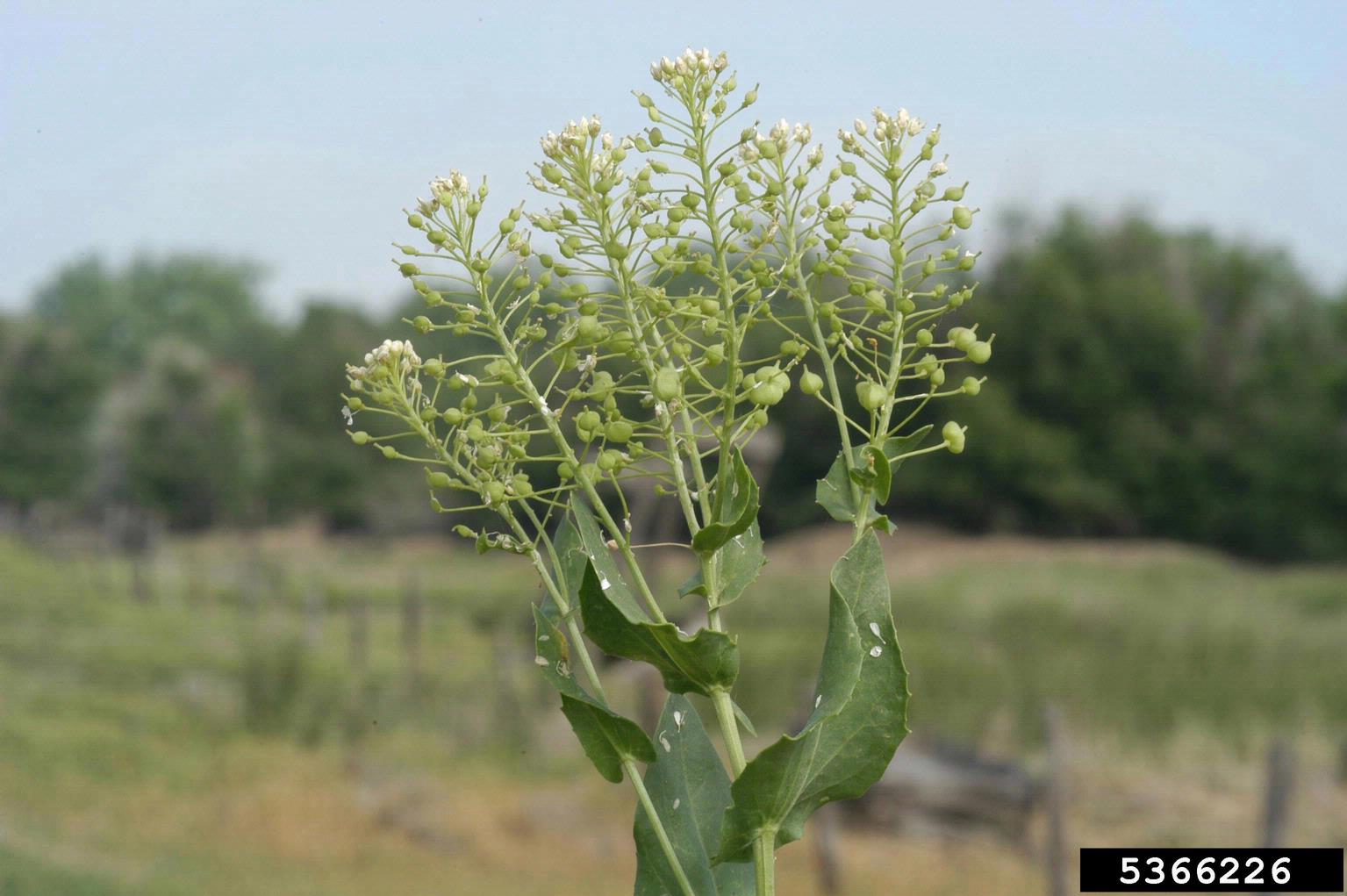
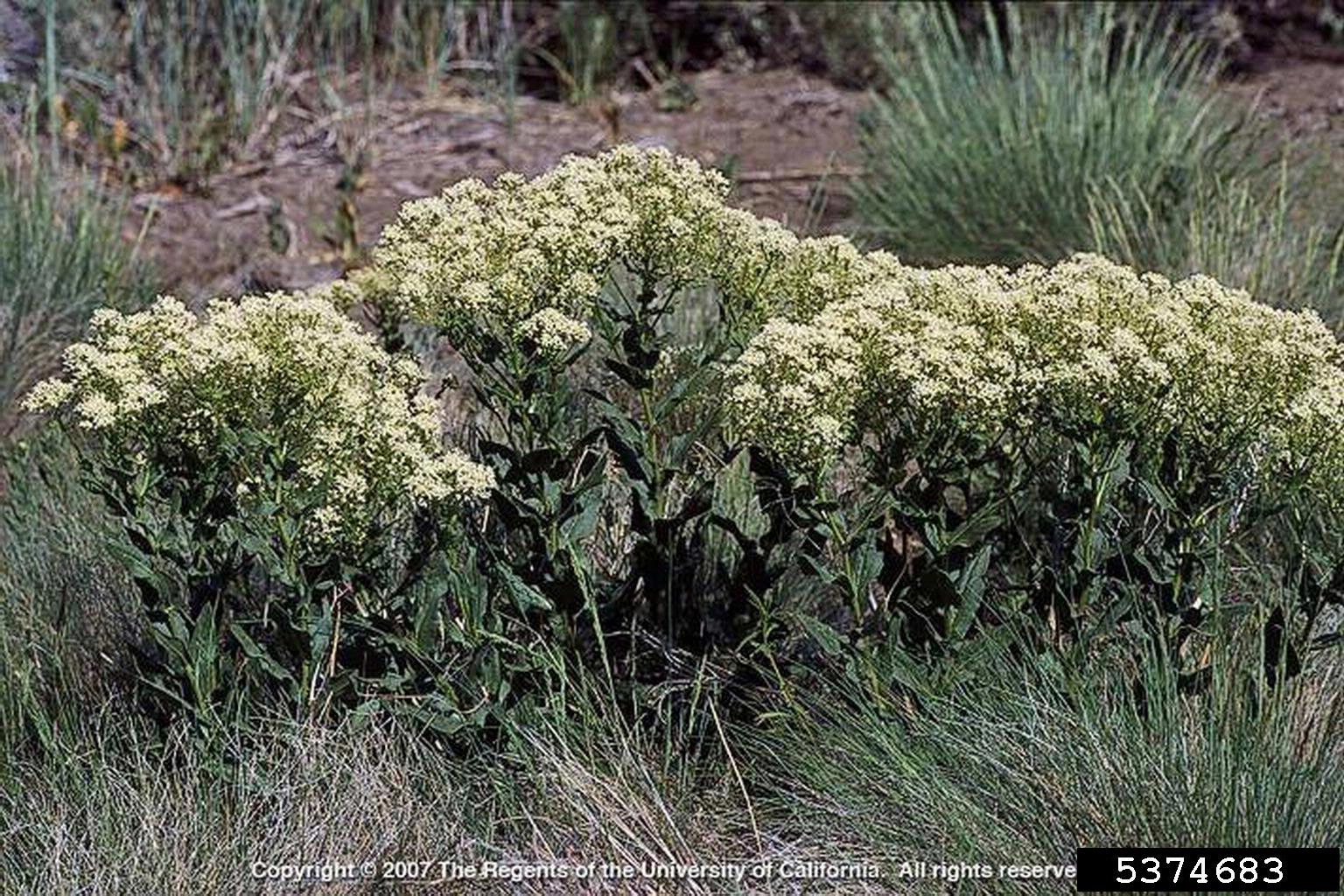
Did you know?
One can harvest and cook the flower heads before they open fully for a broccoli-like dish. The leaves can be used as a spicy addition to salads and are still commonly used as a vegetable in Afghanistan. (note: do not consume any plant without proper identification or where herbicide may have been applied)
